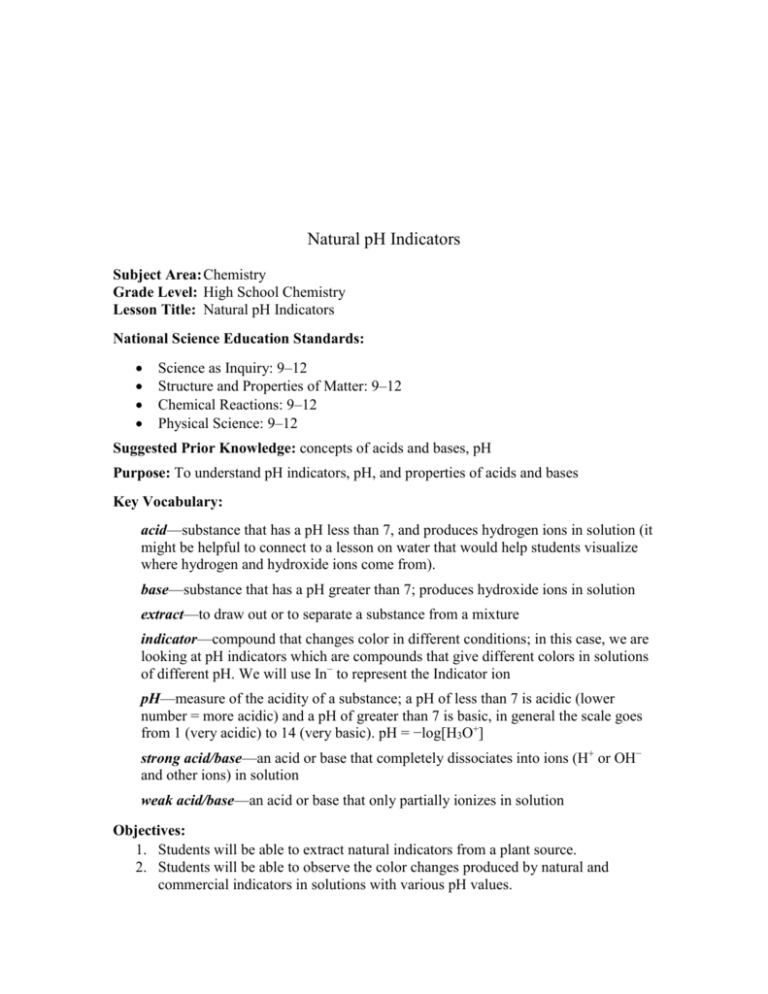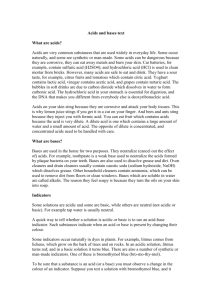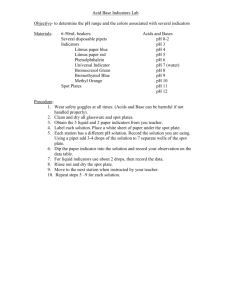Natural pH Indicators
advertisement

Natural pH Indicators Subject Area: Chemistry Grade Level: High School Chemistry Lesson Title: Natural pH Indicators National Science Education Standards: Science as Inquiry: 9–12 Structure and Properties of Matter: 9–12 Chemical Reactions: 9–12 Physical Science: 9–12 Suggested Prior Knowledge: concepts of acids and bases, pH Purpose: To understand pH indicators, pH, and properties of acids and bases Key Vocabulary: acid—substance that has a pH less than 7, and produces hydrogen ions in solution (it might be helpful to connect to a lesson on water that would help students visualize where hydrogen and hydroxide ions come from). base—substance that has a pH greater than 7; produces hydroxide ions in solution extract—to draw out or to separate a substance from a mixture indicator—compound that changes color in different conditions; in this case, we are looking at pH indicators which are compounds that give different colors in solutions of different pH. We will use In− to represent the Indicator ion pH—measure of the acidity of a substance; a pH of less than 7 is acidic (lower number = more acidic) and a pH of greater than 7 is basic, in general the scale goes from 1 (very acidic) to 14 (very basic). pH = −log[H3O+] strong acid/base—an acid or base that completely dissociates into ions (H+ or OH− and other ions) in solution weak acid/base—an acid or base that only partially ionizes in solution Objectives: 1. Students will be able to extract natural indicators from a plant source. 2. Students will be able to observe the color changes produced by natural and commercial indicators in solutions with various pH values. 3. Students will compare the results of these natural indicators with the results of using a commercially available universal indicator. 4. Students will observe the acid/base behavior of pH indicators. 5. Students will use their data and observations to determine the color associated with each indicator in its acid and base form and will approximate the pH at which the color changes occur. Materials: - Safety goggles - Assorted fruits and flowers that can be used as pH indicator sources (list of these attached) - Universal pH Indicator solution or pH test paper - Litmus paper (optional) - pH meter (optional) - Dropper pipettes - Plastic sheet protector or plastic wrap to use as reaction surface - Mortars and pestles (optional) - Hot plates (optional) - Isopropyl (rubbing) alcohol - Colored pencils, crayons, or markers - Beakers, 100 or 150 ml - Various household solutions to test such as: Skim milk Apple juice Light-colored soda Detergent solution Ammonia solution Vinegar solution Diluted orange juice Diluted lemonade Procedure: 1. Discuss with students the concept of pH indicators that give different colors in different pH conditions. Review briefly pH, acids and bases, and pH indicators. A demonstration of how litmus paper changes color in acidic and basic solutions is a good place to start this discussion. Introduce the idea that many naturally occurring substances behave the same way. These natural pH indicators are themselves weak acids and bases. They are dyes that change color depending upon whether they donate or accept protons. In a sufficiently acidic solution, these indicators accept a proton to take the acid form (HIn in general) and in a sufficiently basic solution, they donate a proton to take the basic form (In− in general). Different pH indicators have different acid strengths and will donate or lose a proton at a specific pH. Litmus paper is red in its acid form and blue in its basic form. HIn In− + H+ (red) (blue) 2. Discuss with students how we can design an experiment that allows us to create our own natural pH indicators, to observe the color changes of our natural pH indicators, and to compare these color changes to those of commercially available pH indicators. Begin with a leading question, and follow up: What is the difference between an acid and a base? What pH values do acids have? What pH values do bases have? What kind of investigation can we do to extract natural pH indicators and see their color changes? How can we get the natural indicator substances out of the plant matter? 3. Work with students to design a valid investigation similar to the one outlined in this lesson that will allow them to extract a natural dye and observe its color in solutions of different pH. Comparison to the results given with the universal pH indicator solutions or pH paper will allow them to determine approximate pH values for the solutions. Use of a pH meter is optional, but will give more precise pH values for the solutions. Students should be sure their procedures are detailed and they should create appropriate data tables for their data and observations. All student procedures should be approved by the teacher before students begin any lab work. 4. Lab safety equipment and protocols should be followed. Goggles should be worn at all times. Be especially careful if you are extracting the indicators with alcohol. The room should be well ventilated to avoid buildup of fumes, and ensure that there are no open flames in the laboratory. Students should use care if they are using hot plates. 5. Students may choose their own plant source and extract their own indicator or you may do the extraction of an indicator for them to investigate. There is a wide variety of plant sources, so it is possible to allow students a great deal of freedom in choosing flowers and fruits to test. Extraction of the indicator solutions can be easily carried out in roughly 15 minutes. Students can chop up the plant source into small pieces (or grind using mortars and pestles) then soak the plant parts in alcohol to extract the indicator. This could easily be done the day before the rest of the investigation and the solution left to soak overnight. 6. Extraction methods: Extraction may be done using hot water, 95% denatured ethyl alcohol or 70% isopropyl alcohol. There seems to be no difference obtained from using different solvents, but the alcohols do have an odor so they should only be used in a wellventilated room. Using isopropyl alcohol allows the extraction to be done overnight, with students setting up the extraction one day and performing the rest of the experiment the next day. Another option is herbal tea; e.g., Red Zinger (2 teabags in 100 ml hot water steeped for 15 minutes) also works great, giving red for pH 1–4, golden tan at pH 5–6, and green above 7. Plant options: Natural Fruit and Vegetable Indicators Apple skin (Red) Beets Blueberries Red cabbage Cherries Cranberries Red or purple grapes Red onions Peaches Plums Radish skin Rhubarb skin Strawberries Tomato leaves Turnip skin Natural Flower Indicators Dahlias Daylilies Geraniums Hibiscus Hollyhocks Hydrangeas Blue iris Morning glories Purple mums Pansies Peonies Petunias Poppies Red or pink roses Violets 7. General procedure: a. Obtain a reaction surface (plastic sheet protector or sheet of plastic wrap) and place a sheet of white paper in or under this surface. b. Students can use droppers to place several small drops of each solution to be tested on this reaction surface, making sure these drops are far enough apart to avoid joining together. c. Use two samples of each solution being tested. Test one with the pH test paper or universal indicator solution and the second with the natural indicator students made. d. Have the students record the data and observations from this experiment in an appropriate data table. e. Students can determine approximate pH values from the color chart provided with the commercial pH indicator (or by using the pH meter) and use this information to make their own color chart for their extracted indicator. 8. After the students have finished their investigations, they should be able to describe the acid/base behavior of their natural dye. They should be able to identify the color of the acid and base form of their dyes and they should know the approximate pH at which the form of this dye changes from acid to base. 9. Students may present their findings to their classmates and compare their results with those gathered using a different plant source. Additional Resources: http://www.flinnsci.com/Sections/Safety/safety.asp http://chemistry.about.com/od/acidsbases/Acids_Bases_and_pH.htm http://www.erowid.org/archive/rhodium/chemistry/equipment/ph-indicator.html http://www.ehow.com/list_5931608_flowers-natural-indicators.html http://wow.osu.edu/experiments/chemistry/pH.html Student Worksheet for Natural pH Indicators Experiment Title: _____________________________Date: _______Name: __________ Plant source: _____________________________________________________________ Student Hypothesis: _______________________________________________________ Materials: _______________________________________________________________ ________________________________________________________________________ ________________________________________________________________________ ________________________________________________________________________ ________________________________________________________________________ Procedure: Wear safety goggles for all lab work. ________________________________________________________________________ ________________________________________________________________________ ________________________________________________________________________ ________________________________________________________________________ ________________________________________________________________________ ________________________________________________________________________ ________________________________________________________________________ ________________________________________________________________________ ________________________________________________________________________ ________________________________________________________________________ Data and Observations: Analysis of Data: _________________________________________________________ ________________________________________________________________________ ________________________________________________________________________ ________________________________________________________________________ ________________________________________________________________________ ________________________________________________________________________ ________________________________________________________________________ Conclusion: _____________________________________________________________ ________________________________________________________________________ ________________________________________________________________________ ________________________________________________________________________ ________________________________________________________________________








